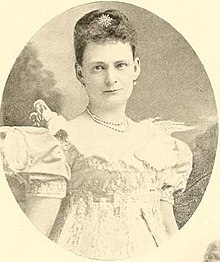Mary Fryer Manning | |
|---|---|
 Portrait from The Washington Sketchbook, 1895 | |
| U.S. Commissioner to the Exposition Universelle | |
| In office 14 April 1900 – 12 November 1900 | |
| President | William McKinley |
| President-General of the National Society Daughters of the American Revolution | |
| In office 1898–1901 | |
| Preceded by | Letitia Green Stevenson |
| Succeeded by | Cornelia Cole Fairbanks |
| Personal details | |
| Born | Mary Margaretta Fryer 1844 Albany, New York, U.S. |
| Died | July 1928 Albany, New York, U.S. |
| Resting place | Albany Rural Cemetery |
| Political party | Democratic |
| Spouse | Daniel Manning |
| Education | Albany Academy for Girls |
| Occupation | Social leader |
| Signature | |
Mary Margaretta Fryer Manning (1844–1928) was an American social leader with wide experience in business, social, and philanthropic areas.[1] President William McKinley appointed her commissioner to the Exposition Universelle (Paris, 1900), and to represent the U.S. and the Daughters of the American Revolution (DAR) at the unveiling of the statue of Gilbert du Motier, Marquis de Lafayette in Paris, on July 4, 1900. On July 3, 1900, she assisted in unveiling the statue of George Washington, a gift of the women of the U.S. to France.[2] Among her many roles, Manning served as President-General of the DAR for two terms.[3] During the years that her husband, Daniel Manning held the portfolio of the United States Secretary of the Treasury their home in Washington, D.C. became a center of social and political affairs in Washington. After widowhood in 1887, she spent part of each year in Washington. Her patriotism was shown in her work for the DAR Mohawk Chapter of Albany, New York, of which she was regent.[4]
- ^ Fallows, Samuel; Buckley, Edmund; Mathews, Shailer (1904). "Mrs. Daniel Manning". Current Encyclopedia: A Monthly Record of Human Progress ... Current Encyclopedia Company. p. 258. Retrieved 10 May 2024.
 This article incorporates text from this source, which is in the public domain.
This article incorporates text from this source, which is in the public domain.
- ^ Woman's Who's who of America: A Biographical Dictionary of Contemporary Women of the United States and Canada. American Commonwealth Company. 1914. p. 537. Retrieved 10 May 2024.
 This article incorporates text from this source, which is in the public domain.
This article incorporates text from this source, which is in the public domain.
- ^ The National Cyclopaedia of American Biography. Vol. 12. New York: J. T. White & Company. 1904. p. 335. Retrieved 9 May 2024.
 This article incorporates text from this source, which is in the public domain.
This article incorporates text from this source, which is in the public domain.
- ^ Logan, Mrs John A. (1912). The Part Taken by Women in American History. Perry-Nalle Publishing Company. p. 471. Retrieved 10 May 2024.
 This article incorporates text from this source, which is in the public domain.
This article incorporates text from this source, which is in the public domain.